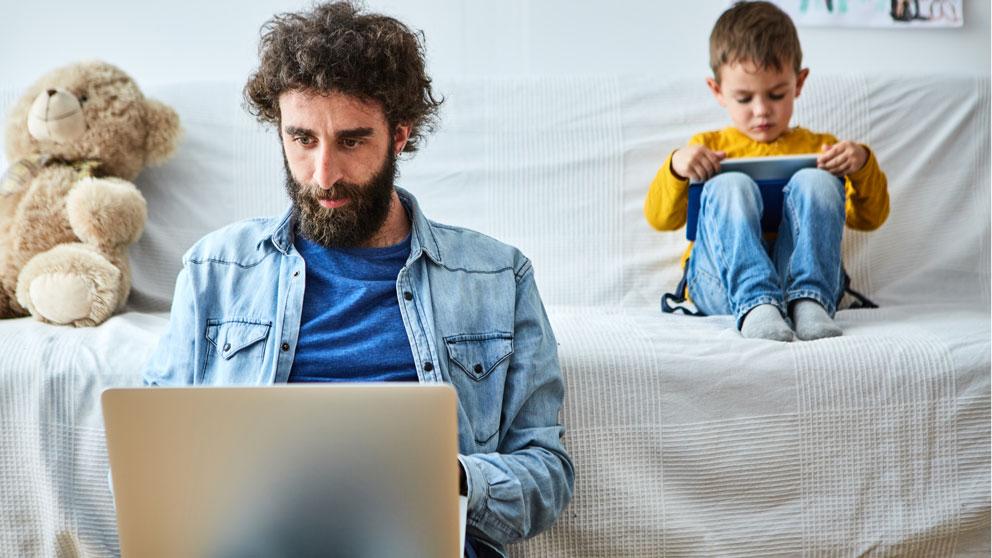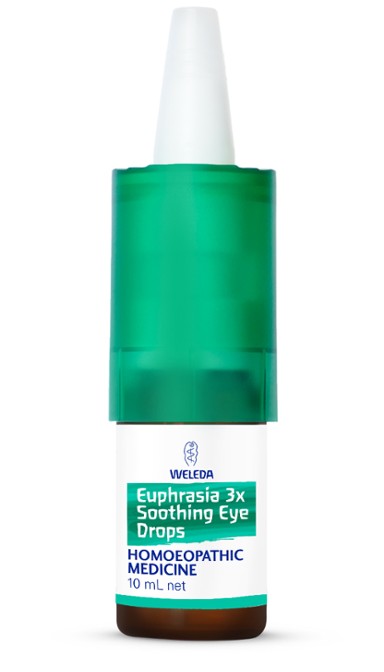
Screen time and blue light
How can we protect our eyes
Does the blue light from monitors harm our eyes? How much screen time is enough? It’s a familiar topic for all parents and children’s caregivers today. We are all too familiar with our own use of smartphones, tablets and other digital devices.
Challenges for our eyes
Many parents ask themselves, “Is it safe to let my baby or toddler play with my mobile phone?” Children and teens in particular need our support in using digital devices responsibly and the “smart” use of their smartphone. Parents are often surprised when they learn how many hours their children spend online. Yet it’s common knowledge that the widespread and frequent use of digital media is steadily growing. Even our youngest children want to play with mobile phones, fascinated by their moving images. At the same time, many of us are spending less time outdoors, decreasing our exposure to sunlight.
Increasingly common workplace-related eye and vision problems are often referred to as “computer vision syndrome” (CVS) or “digital eye strain”. Many of us stare at a computer screen for hours on end. This leads to eye fatigue, dry eyes, and blurred vision. And when we finally do go outside, our eyes are prone to unexpected and excessive tearing.
Smaller screens on tablets and smartphones
We use our smartphones throughout the day, during and after hours of work at the computer. Words, images and symbols on portable digital devices are very small in comparison to those on desktop monitors. Customary rapid scrolling, tapping and swiping through these images aggravates existing computer vision syndrome symptoms. The overall time we humans spend looking at screens is getting longer and longer.
Doctors warn against excessive screen time and lack of daylight exposure
Adverse effects have been associated with the extended, daily use of electronic media, particularly at a young age.
Increase in myopia, especially in industrialised countries
Environmental factors and changes in human behaviour have been identified as the cause of increased myopia (short-sightedness), especially in industrialised countries. Many children and teenagers no longer spend their free time outdoors under the sun but in front of PCs, smartphones and tablets, starting early in the day.
The World Health Organization (WHO) has declared the growing incidence of myopia to be a global health problem
Whereas myopia was previously considered a mere discomfort, today it is recognized as an eye defect that can lead to impaired vision.
Short-sightedness (also called nearsightedness) typically develops in childhood and adolescence, because the eye only grows in this phase of life. The reasons for myopia, which occurs if the eyeball is too long or if the cornea is too curved, were long a mystery. For many years, scientists could only prove the connection between hereditary predispositions and environmental factors. They also noticed more frequent cases of myopia among people with higher levels of education. This points to the possibility that prolonged focusing on close-up objects such as books might also lead to short-sightedness.
Lack of light under suspicion
There is still insufficient data to prove that the long-term use of smartphones is harmful to our eyes. However, ophthalmologists assume that there is a correlation between the increasing use of smartphones and computers and the negative impact on our eyes. Exposure to natural daylight is considered to be an important protective factor against short-sightedness. (See Prof. Bettina Wabbels, statement at the 116th Congress of the German Ophthalmological Society (DOG).)
How much screen time is enough?
Recommendations for children
According to a statement issued by the German Ophthalmological Society (DOG) in September 2018, the use of PCs, smartphones or tablets is not at all suitable for children under the age of 3 years. For children aged 4 to 6, a maximum screen time of 30 minutes per day is tolerable. Smartphones and tablets should not be used as “babysitters”. If children use them, then ideally together with their caregivers. Digital devices should not replace the act of reading or viewing picture books together. Preschool-aged children should first have the opportunity to explore real life before turning to screens. And when they do, a minimum distance of 30 cm between the eyes and the smartphone should be maintained during use.
Furthermore, the German Ophthalmological Society (DOG) advises that viewing of digital media should be limited to one hour per day for children of primary school age. Starting at age 10, no more than two hours a day of screen time is recommended. Younger children of pre-school and lower primary-school age tend to use digital devices belonging to their parents or caregivers; older children and teens tend to have their own digital devices. In any case, there should be clear rules as to their use, which could also involve limiting and monitoring screen time with the help of an app. And one to two hours before bedtime, electronic media should not be used at all.
Digital devices: tips for families
- Monitor your and your children’s screen time.
- Children under the age of three should not use electronic media at all.
- Digital devices should be held at least 30 to 40 cm away from the eyes.
- Take a break after every hour of screen use.
- Look into the distance every ten minutes during longer sessions.
- Use larger screens when working with longer documents.
- Keep your eyes moving as much as possible; try not to stare at the computer screen.
- Blink frequently to moisturise the eyes.
- To relax the optic nerve, look into the distance.
- Children and teens in particular should spend more time outdoors in daylight – at least two hours a day if possible.
Dry eyes?
When the tear film of our eyes becomes imbalanced, it can lead to dry eyes, with redness, irritation and a gritty feeling under the eyelid.
Sources:
- Professor Dr. med. Bettina Wabbels, Head of the Department of Orthoptics, Neuro- and Pediatric Ophthalmology, University Eye Clinic Bonn.
- German Federal Centre for Health Education. 2014. Gut hinsehen und zuhören! – Ratgeber für Eltern. Tipps und Informationen für Eltern zum Thema „Mediennutzung in der Familie". https://www.bzga.de/infomaterialien/kinder-und-jugendgesundheit/gut-hinsehen-und-zuhoeren-ratgeber-fuer-eltern/
- Williams KM, et al. 2015. Prevalence of refractive error in Europe: the European Eye Epidemiology (E(3)) Consortium. European Journal of Epidemiology. 2015; 30(4): 305–315. Published online 2015 Mar 18. doi: 10.1007/s10654-015-0010-0. https://www.ncbi.nlm.nih.gov/pmc/articles/PMC4385146/
- Xiong, S. et al. 2017. Time spent in outdoor activities in relation to myopia prevention and control: a meta-analysis and systematic review, Acta Ophthalmologica. 2017 Sep; 95(6): 551–566. Published online 2017 Mar 2. doi: 10.1111/aos.13403. https://www.ncbi.nlm.nih.gov/pmc/articles/PMC5599950/
- Proceedings from the 116the Congress of the German Ophthalmological Society (DOG), September 2018. https://www.dog.org/wp-content/uploads/2018/01/PM-DOG-2018-Mediennutzung-September-2018_F.pdf
- German Federal Commissioner on Drug Policy, Parent recommendations for healthy media consumption, https://www.drogenbeauftragte.de/fileadmin/dateien-dba/Drogenbeauftragte/4_Presse/1_Pressemitteilungen/2018/2018_I.Q/2018-03-02_BVKJ_Empfehlungen.pdf
- BVA/DOG Brochure on Myopia, https://augeninfo.de/cms/fileadmin/pat_brosch/myopie.pdf
- Chang, AM et al. 2014. Evening use of light-emitting eReaders negatively affects sleep, circadian timing and next-morning alertness. Proceedings of the National Academy of Sciences of the United States of America (PNAS). 2015 Jan 27; 112(4): 1232–1237. Published online 2014 Dec 22. doi: 10.1073/pnas.1418490112, https://www.ncbi.nlm.nih.gov/pmc/articles/PMC4313820/











